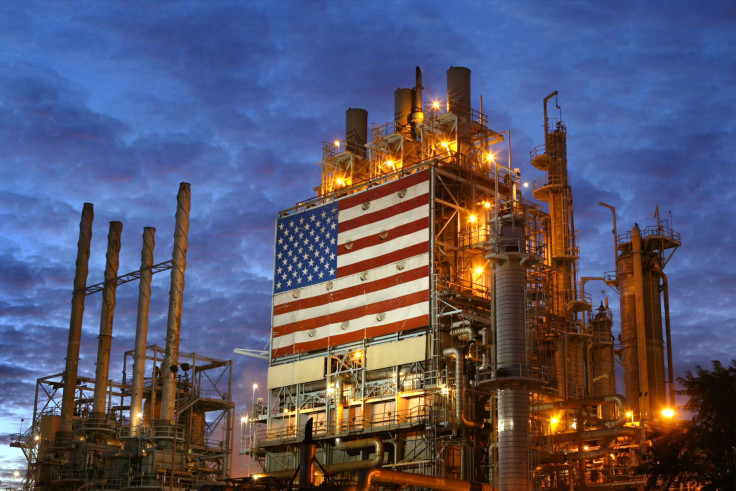Trump Tweets That Oil Is Too High -- But Is He The One To Blame?

Earlier this week, President Trump tweeted out that "oil prices are too high, OPEC is at it again. Not good!" The tweet comes after crude prices in the U.S. have jumped about 40% in the past year to around $65 a barrel, though they're down about 10% from a peak of more than $70 a barrel a few weeks ago. This surge has driven the price of gas up to an average of $2.90 a gallon, according to AAA, an increase of 25% from this time last year. That higher gas price is starting to cause some pain at the pump and, likely, complaints from voters.
This article originally appeared in The Motley Fool.
However, while OPEC's actions are one of the reasons crude has moved higher, it isn't entirely to blame. Several other factors have accelerated crude's rise, including a direct action by the president.
OPEC Takes A Step To Sort Out The Oil Market's Mess
In late November of 2016, OPEC announced that it would cap its production at 32.5 million barrels per day (BPD) for six months starting in January of 2017, which represented a reduction of about 1.2 million BPD. A few weeks later, it announced an agreement with several non-member nations, including Russia, that pledged to curb their output by 558,000 BPD for the first six months of 2017. This coordinated effort would reduce global supplies below demand so that the oil market could burn off some of the excess crude sitting in storage depots around the world. That glut formed after shale drillers in the U.S. unleashed a gusher of production in the preceding years that was too much for the oil market to handle.
OPEC would go on to extend this agreement twice, with the current pact set to expire at the end of this year. The plan has largely accomplished its goal since global oil storage levels are now back within their five-year average. Because of that, OPEC has had discussions about ending the agreement early, especially given some supply issues within the group.
Problems At The Oil Pump
One problem area has been Venezuela. Two years ago, the South American country was producing 2.2 million BPD. However, its output is collapsing thanks to the nation's growing economic crisis. Production hit a three-decade low of 1.6 million BPD in January -- 20% below the year-ago level -- and could fall another 550,000 BPD, or 40% from its current pace, which is a big reason crude prices have risen so sharply in recent months.
An Action With A Clear Reaction
Meanwhile, production within OPEC could fall further in the coming months after President Trump promised to impose "powerful" sanctions on Iran by pulling the U.S. out of the nuclear deal. The last time the U.S. imposed sanctions on Iran, its oil exports fell by 1.2 million BPD. While it's unclear how much oil Trump's sanctions will remove from the market this time, oil prices have already moved sharply this year in anticipation that the president would reimpose sanctions. According to one analyst, the sanctions alone could add $5 to the cost of a barrel of oil.
Cashing In After Years Of Pain
While Trump has called for other OPEC nations to pick up the slack from Iran, it's worth pointing out that OPEC isn't the only group of producers that have been standing pat as prices soar. Oil companies in the U.S. have shown no desire to boost spending or drill more wells in response to higher oil prices. EOG Resources (NYSE:EOG), which is one the largest shale drillers in the country, said, "2018 is all about maintaining our disciplined capital growth program." Because of that, EOG Resources is sticking to its $5.8 billion capital budget. While that's enough money to grow its oil production 16%, EOG could increase output even faster at current prices. At $60 a barrel, the company could boost production at a 25% compound annual rate through 2020. However, instead of ramping up to that rate, the company is on pace to generate more than $1.5 billion in excess cash this year as long as oil averages $60 a barrel.
Marathon Oil (NYSE:MRO), likewise, said it would stick with its $2.3 billion drilling budget, which is enough money to grow oil and gas production in the U.S. by 25% to 30% versus last year. Because of that capital discipline, Marathon is on pace to produce more than $500 million in excess cash this year, and that's assuming crude averages $60 a barrel.
Instead of drilling more wells, many shale drillers are using their windfall from higher oil prices to go on a stock buyback binge. Meanwhile, others like EOG and Marathon are using some of the money to pay off debt as well as increase dividends.
It's Not All OPEC's Fault
OPEC clearly lit a fire under oil prices almost two years ago, when it took steps to accelerate the oil market's recovery. However, it's not entirely to blame for the surge in crude prices over the last few months. Venezuela's output has fallen off a cliff due to a worsening economic crisis. Meanwhile, oil producers in the U.S. are purposely holding back on drilling more wells so they can cash in on higher prices. Finally, Trump himself has added a few dollars to the cost of crude by reimposing sanctions on Iran. Those factors will likely keep oil elevated even if OPEC eventually boosts its production. While that's not ideal for oil consumers (or voters), it does make some oil stocks compelling investment options worth considering.
Matthew DiLallo has no position in any of the stocks mentioned. The Motley Fool has no position in any of the stocks mentioned. The Motley Fool has a disclosure policy.




















